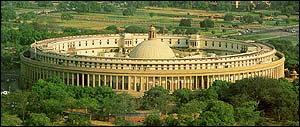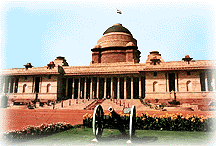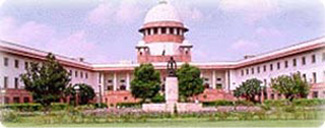
|

|

|

|

|

|

|
Government in India
India is a Parliamentary based, democratic republic. It is governed by its Constitution that took effect on November 26, 1950. Unlike the United States, India has both a Prime Minister and a President. On the Federal level, it also has a Supreme Court, two legislative houses, and a Council of Ministers. The states have their own governors and elected representatives as well as state judiciary systems.
The Executive Branch
The Legislative Branch
The Judicial Branch

The Executive Branch:

| The President:
The President is the constitutional Executive of the Union. This office is determined by an electoral college comprised of popularly elected members of both houses of Parliament and state legislatures. In India, the President serves a term of 5 years and is supreme commander of the armed forces. He or she appoints the Prime Minister, governors, and Supreme Court justices. The President also has the power to declare emergency if there is reasonable evidence of a threat to national security, threat of war, or an armed rebellion. Despite these powers, the President is obligated to act based on the advice of the Prime Minister and the Council of Ministers. This is not only true by tradition, but, as of 1976, also by the 42nd Amendment to the Constitution. In practice, the role of the President is mainly symbolic and procedural. |
| The Prime Minister:
The Prime Minister is selected by the President and is almost always the head of the majority party in Parliament. If no single party carries a majority, the Prime Minister is the head of the largest party, but must then recieve a vote of confidence from the legislature. He or she is the "Head of the Government", as opposed to the "Head of State", and oversees the daily work of government. The Prime Minister works with a Council of Ministers, made up of cabinet posts and ministers of state. The Prime Minister retains his or her place in the legislature and becomes the leader of that House. He or she is also the head of the Planning Commission, which is responsible for assessing resources and setting the national agenda. The Prime Minister deals with issues of defence, domestic and foreign policy, committee appointments, and appointment to state tribunals. |

The Legislative Branch:

| The Lok Sabha:
The Lok Sabha is the lower house of Parliament, literally translated as the "Council of the People". It has 545 members who are elected by the people of India. Representatives come from the Indian states, in ratio to the state's population. A representative in the Lok Sabha must be at least 25 years old. From these representatives, a Speaker of the Lok Sabha is elected. He or she is responsible for the organization and administration of the Lok Sabha business. The Lok Sabha sits for 5 years, unless it is dissolved prior to that date. It handles bills, motions, budgets, and national or foreign policy. Monetary bills must come from the Lok Sabha, and this body has primary control over them throughout the process.The Council of Ministers must report to the Lok Sabha. |
| The Rajya Sabha:
The Rajya Sabha is the "Council of States". It is the upper house of Parliament, and has about 250 members. Here, a representative must be at least 30 years old. Most of the members of the Rajya Sabha are elected by the state governments, but 12 are appointed by the president. The Vice President of India is the ex-officio Chairman of the Rajya Sabha. Members of this body serve for 6 years. Unlike the Lok Sabha, the Rajya Sabha may not be dissolved. However, one-third of its members retire every second year. In order for a bill to pass Parliament, there must be concurrence of both the Lok Sabha and the Rajya Sabha. The Rajya Sabha has equal power to the Lok Sabha, except in the case of Budget and Finance Bills. |

The Judicial Branch:

| The Indian judicial system has 3 main levels. There is the Supreme Court, the High State
Courts, and the State district courts. The Supreme Court has immediate jurisdiction over cases between
nations or between the federal government and the states. It also handles appeals from lower courts and
is the final legal authority in the judicial system.
The President appoints justices to the Supreme Court on the advice of the Prime Minister. There is a chief justice and 25 other justices. Justices must be Indian citizens, have presided over a High Court office for 5 years, and have been an advocate for the High Court for 10 years. Supreme Court justices are obligated to retire at the age of 65. |
The creator of this site would like to thank:
Erin Pembrey Swan, author of "India: Enchantment of the World"
The offices of the Lok Sabha, Rajya Sabha, and Supreme Court (may be reached through the Government directory at http://goidirectory.nic.in/)
